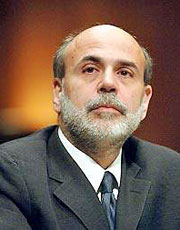Bernanke’s Money Printing Monetary Policy Is Doomed!
Interest-Rates / Quantitative Easing Nov 10, 2010 - 09:12 AM GMTBy: Claus_Vogt
 Last week Ben Bernanke wrote an article for The Washington Post to justify the Fed’s decision of another round of quantitative easing. Here’s his core argument:
Last week Ben Bernanke wrote an article for The Washington Post to justify the Fed’s decision of another round of quantitative easing. Here’s his core argument:
“Easier financial conditions will promote economic growth. For example, lower mortgage rates will make housing more affordable and allow more homeowners to refinance. Lower corporate bond rates will encourage investment.
“And higher stock prices will boost consumer wealth and help increase confidence, which can also spur spending. Increased spending will lead to higher incomes and profits that, in a virtuous circle, will further support economic expansion.”
It looks to me like the world’s most powerful central banker hasn’t learned anything from recent financial history. He seems to resist the overwhelming evidence that the Fed’s bubble-blowing policy since the second half of the 1990s has failed miserably.
And he seems convinced that the current economic malaise can be remedied by more easy-money.
I was critical of Greenspan’s stock market bubble policy of the late 1990s. And in 2004 I wrote the book, The Greenspan Dossier, where I described the state of the housing market and predicted the severe consequences of its unavoidable bursting:
“When the U.S. real estate bubble bursts it will not only trigger a recession and a stock market crash, but it will endanger the entire financial system, especially Fannie Mae and Freddie Mac.”
These predictions were clearly spot on. Now, here we are two burst bubbles later, and the Fed chairman maintains his bubble-creating policies! And in his Washington Post article he clearly tells us he wants to create another stock market bubble to boost consumer spending and the economy.
|
I think Bernanke’s policy is doomed, mainly because …
The Markets Can Be Stronger than the Manipulators!
Many stock market participants remember the past decade’s roller-coaster ride when the market lost half its value … twice! And they just might not be willing to be led into the same trap a third time.
So market forces could turn out to be stronger than the central bank’s market manipulation efforts.
And it’s not the first time that has happened …
Years ago many central bankers learned this lesson in the currency markets when their interventions totally failed to change currency trends. And with the Bank of Japan we have a prime example of failed central bank manipulations of the stock market.
As you can see in the chart below, the Nikkei shot up 22 percent following the BOJ’s quantitative easing announcement in March 2001. But the party was a short one …
|
From May 1, 2001 through September 17, 2001, the Japanese market lost all of those gains — and more — tumbling 34.1 percent.
It’s really ironic …
When the twin bubbles in Japan burst — a stock market bubble followed by a housing bubble — the Japanese authorities answered in exactly the same way their U.S. counterparts are doing now.
They implemented the same fiscal and monetary policies grounded in the same faulty arguments — and failed miserably. Even more ironic is the fact that the U.S. was Japan’s sternest critic.
Here we go: Same problems, same short-term fixes — yet Bernanke is hoping for different outcomes. But given all that ails the economy, I think Helicopter Ben is in for a very unpleasant surprise.
Best wishes,
Claus
This investment news is brought to you by Money and Markets. Money and Markets is a free daily investment newsletter from Martin D. Weiss and Weiss Research analysts offering the latest investing news and financial insights for the stock market, including tips and advice on investing in gold, energy and oil. Dr. Weiss is a leader in the fields of investing, interest rates, financial safety and economic forecasting. To view archives or subscribe, visit http://www.moneyandmarkets.com.
© 2005-2022 http://www.MarketOracle.co.uk - The Market Oracle is a FREE Daily Financial Markets Analysis & Forecasting online publication.





